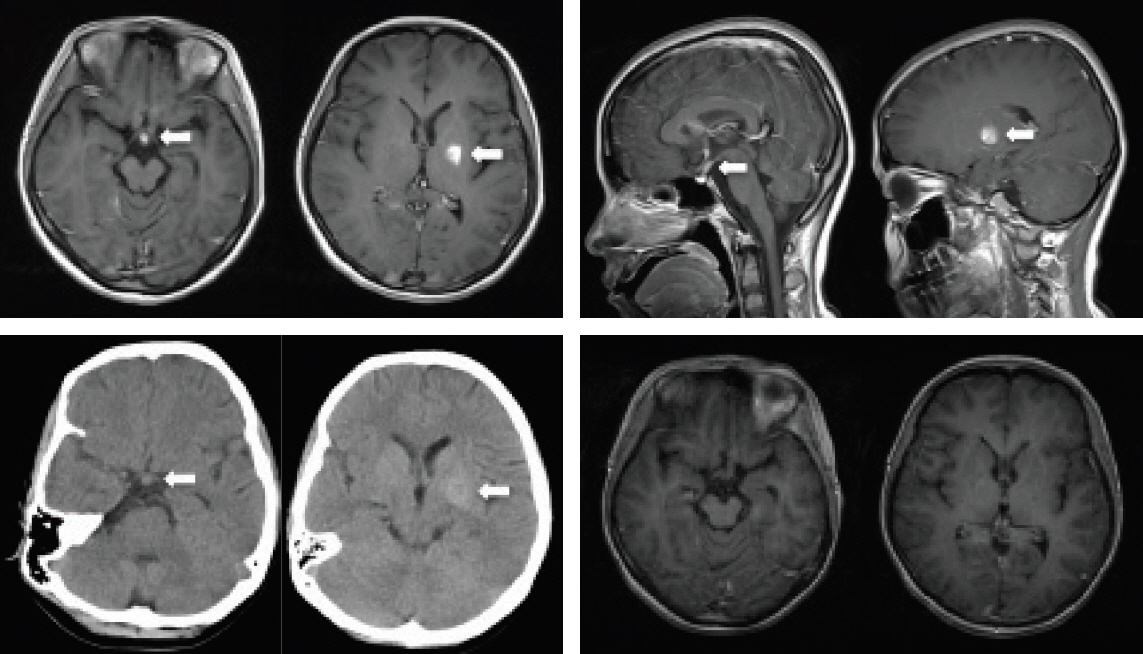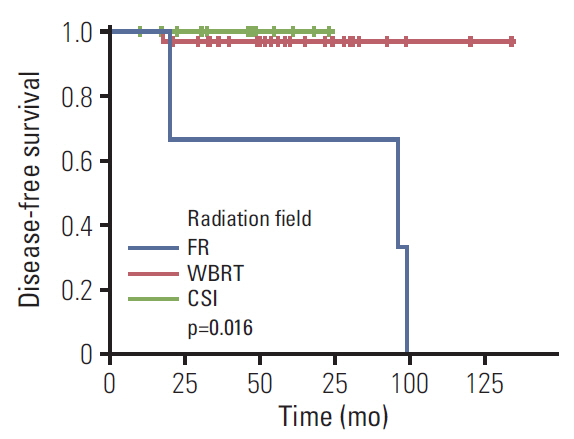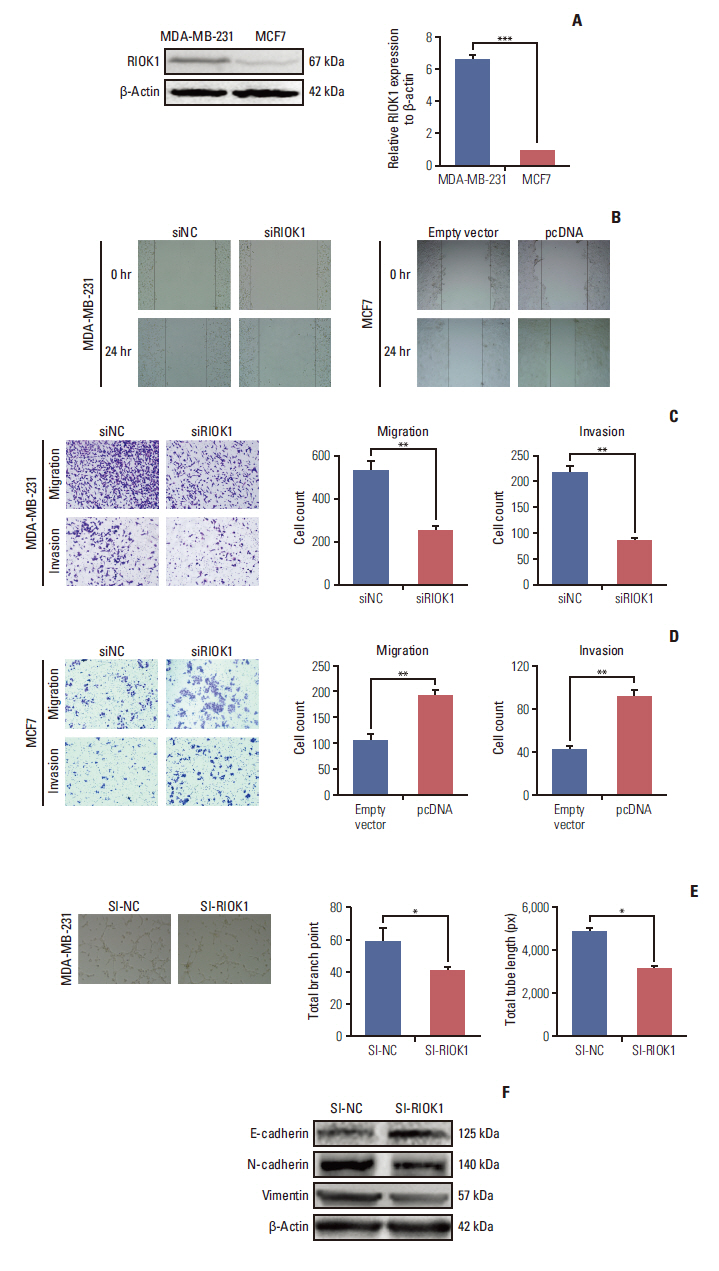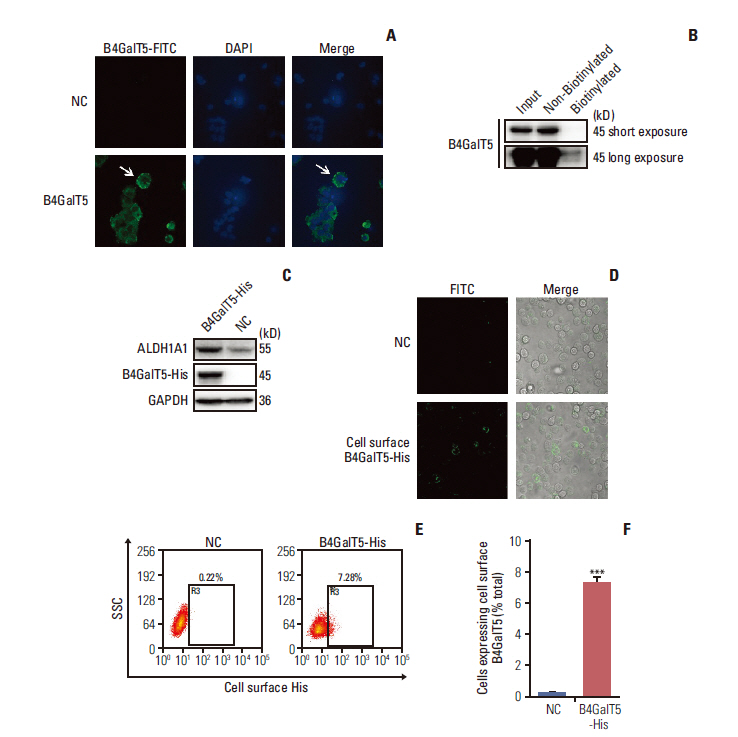Cancer Res Treat.
2020 Oct;52(4):1050-1058. 10.4143/crt.2020.437.
Comparison between Craniospinal Irradiation and Limited-Field Radiation in Patients with Non-metastatic Bifocal Germinoma
- Affiliations
-
- 1Department of Radiation Oncology, Beijing Tiantan Hospital, Capital Medical University, Beijing, China
- 2Beijing Neurosurgical Institute, Capital Medical University, Beijing, China
- 3Department of Neurosurgery, Beijing Tiantan Hospital, Capital Medical University, Beijing, China
- 4Department of Clinical Nutrition, Beijing Children’s Hospital, Capital Medical University, Beijing, China
- 5Centre of Endocrinology Genetics and Metabolism, National Centre for Children’s Health, Beijing Children’s Hospital, Capital Medical University, Beijing, China
- KMID: 2507932
- DOI: http://doi.org/10.4143/crt.2020.437
Abstract
- Purpose
Whether craniospinal irradiation (CSI) could be replaced by limited-field radiation in non-metastatic bifocal germinoma remains controversial. We addressed the issue based on the data from our series and the literature.
Methods
Data from 49 patients diagnosed with non-metastatic bifocal germinoma at our hospital during the last 10 years were collected. The Pediatric Quality of Life Inventory 4.0 was used to evaluate health-related quality of life (HRQOL). Additionally, 81 patients identified from the literature were also analyzed independently.
Results
In our cohort, 34 patients had tumors in the sellar/suprasellar (S/SS) plus pineal gland (PG) regions and 15 in the S/SS plus basal ganglia/thalamus (BG/T) regions. The median follow-up period was 52 months (range, 10 to 134 months). Our survival analysis showed that patients treated with CSI (n=12) or whole-brain radiotherapy (WBRT; n=34) had comparable disease-free survival (DFS; p=0.540), but better DFS than those treated with focal radiotherapy (FR; n=3, p=0.016). All 81 patients from the literature had tumors in the S/SS+PG regions. Relapses were documented in 4/45 patients treated with FR, 2/17 treated with whole-ventricle irradiation, 0/4 treated with WBRT, and 1/15 treated with CSI. Survival analysis did not reveal DFS differences between the types of radiation field (p=0.785). HRQOL analysis (n=44) in our cohort found that, compared with S/SS+PG germinoma, patients with BG/T involvement had significantly lower scores in social and school domains. However, HRQOL difference between patients treated with CSI and those not treated with CSI was not significant.
Conclusion
In patients with non-metastatic bifocal germinoma, it is rational that CSI could be replaced by limited-field radiation. HRQOL in patients with BG/T involvement was poorer.
Keyword
Figure
Reference
-
References
1. Lee SH, Jung KW, Ha J, Oh CM, Kim H, Park HJ, et al. Nationwide population-based incidence and survival rates of malignant central nervous system germ cell tumors in Korea, 2005-2012. Cancer Res Treat. 2017; 49:494–501.
Article2. Murray MJ, Horan G, Lowis S, Nicholson JC. Highlights from the Third International Central Nervous System Germ Cell Tumour Symposium: laying the foundations for future consensus. Ecancermedicalscience. 2013; 7:333.
Article3. Gao Y, Jiang J, Liu Q. Clinicopathological and immunohistochemical features of primary central nervous system germ cell tumors: a 24-years experience. Int J Clin Exp Pathol. 2014; 7:6965–72.4. Wong TT, Chen YW, Guo WY, Chang KP, Ho DM, Yen SH. Germinoma involving the basal ganglia in children. Childs Nerv Syst. 2008; 24:71–8.
Article5. Rasalkar DD, Chu WC, Cheng FW, Paunipagar BK, Shing MK, Li CK. Atypical location of germinoma in basal ganglia in adolescents: radiological features and treatment outcomes. Br J Radiol. 2010; 83:261–7.
Article6. Bamberg M, Kortmann RD, Calaminus G, Becker G, Meisner C, Harms D, et al. Radiation therapy for intracranial germinoma: results of the German cooperative prospective trials MAKEI 83/86/89. J Clin Oncol. 1999; 17:2585–92.
Article7. Maity A, Shu HK, Janss A, Belasco JB, Rorke L, Phillips PC, et al. Craniospinal radiation in the treatment of biopsy-proven intracranial germinomas: twenty-five years’ experience in a single center. Int J Radiat Oncol Biol Phys. 2004; 58:1165–70.
Article8. Calaminus G, Frappaz D, Kortmann RD, Krefeld B, Saran F, Pietsch T, et al. Outcome of patients with intracranial non-germinomatous germ cell tumors-lessons from the SIOP-CNS-GCT-96 trial. Neuro Oncol. 2017; 19:1661–72.
Article9. Calaminus G, Kortmann R, Worch J, Nicholson JC, Alapetite C, Garre ML, et al. SIOP CNS GCT 96: final report of outcome of a prospective, multinational nonrandomized trial for children and adults with intracranial germinoma, comparing craniospinal irradiation alone with chemotherapy followed by focal primary site irradiation for patients with localized disease. Neuro Oncol. 2013; 15:788–96.
Article10. Goldman S, Bouffet E, Fisher PG, Allen JC, Robertson PL, Chuba PJ, et al. Phase II trial assessing the ability of neoadjuvant chemotherapy with or without second-look surgery to eliminate measurable disease for nongerminomatous germ cell tumors: a children’s oncology group study. J Clin Oncol. 2015; 33:2464–71.
Article11. Aoyama H, Shirato H, Ikeda J, Fujieda K, Miyasaka K, Sawamura Y. Induction chemotherapy followed by low-dose involved-field radiotherapy for intracranial germ cell tumors. J Clin Oncol. 2002; 20:857–65.
Article12. Al-Mahfoudh R, Zakaria R, Irvine E, Pizer B, Mallucci CL. The management of bifocal intracranial germinoma in children. Childs Nerv Syst. 2014; 30:625–30.
Article13. Lafay-Cousin L, Millar BA, Mabbott D, Spiegler B, Drake J, Bartels U, et al. Limited-field radiation for bifocal germinoma. Int J Radiat Oncol Biol Phys. 2006; 65:486–92.
Article14. Huang PI, Chen YW, Wong TT, Lee YY, Chang KP, Guo WY, et al. Extended focal radiotherapy of 30 Gy alone for intracranial synchronous bifocal germinoma: a single institute experience. Childs Nerv Syst. 2008; 24:1315–21.15. Weksberg DC, Shibamoto Y, Paulino AC. Bifocal intracranial germinoma: a retrospective analysis of treatment outcomes in 20 patients and review of the literature. Int J Radiat Oncol Biol Phys. 2012; 82:1341–51.
Article16. van Battum P, Huijberts MS, Heijckmann AC, Wilmink JT, Nieuwenhuijzen Kruseman AC. Intracranial multiple midline germinomas: is histological verification crucial for therapy? Neth J Med. 2007; 65:386–9.17. Merchant TE, Sherwood SH, Mulhern RK, Rose SR, Thompson SJ, Sanford RA, et al. CNS germinoma: disease control and long-term functional outcome for 12 children treated with craniospinal irradiation. Int J Radiat Oncol Biol Phys. 2000; 46:1171–6.
Article18. Ogawa K, Yoshii Y, Shikama N, Nakamura K, Uno T, Onishi H, et al. Spinal recurrence from intracranial germinoma: risk factors and treatment outcome for spinal recurrence. Int J Radiat Oncol Biol Phys. 2008; 72:1347–54.
Article19. Baranzelli MC, Patte C, Bouffet E, Couanet D, Habrand JL, Portas M, et al. Nonmetastatic intracranial germinoma: the experience of the French Society of Pediatric Oncology. Cancer. 1997; 80:1792–7.20. Cuccia V, Alderete D. Suprasellar/pineal bifocal germ cell tumors. Childs Nerv Syst. 2010; 26:1043–9.
Article21. Shikama N, Ogawa K, Tanaka S, Toita T, Nakamura K, Uno T, et al. Lack of benefit of spinal irradiation in the primary treatment of intracranial germinoma: a multiinstitutional, retrospective review of 180 patients. Cancer. 2005; 104:126–34.22. Sugiyama K, Uozumi T, Arita K, Kiya K, Kurisu K, Sumida M, et al. Clinical evaluation of 33 patients with histologically verified germinoma. Surg Neurol. 1994; 42:200–10.
Article23. Rogers SJ, Mosleh-Shirazi MA, Saran FH. Radiotherapy of localised intracranial germinoma: time to sever historical ties? Lancet Oncol. 2005; 6:509–19.
Article24. Alapetite C, Brisse H, Patte C, Raquin MA, Gaboriaud G, Carrie C, et al. Pattern of relapse and outcome of non-metastatic germinoma patients treated with chemotherapy and limited field radiation: the SFOP experience. Neuro Oncol. 2010; 12:1318–25.25. Lee DS, Lim DH, Kim IH, Kim JY, Han JW, Yoo KH, et al. Upfront chemotherapy followed by response adaptive radiotherapy for intracranial germinoma: prospective multicenter cohort study. Radiother Oncol. 2019; 138:180–6.
Article26. Bowzyk Al-Naeeb A, Murray M, Horan G, Harris F, Kortmann RD, Nicholson J, et al. Current management of intracranial germ cell tumours. Clin Oncol (R Coll Radiol). 2018; 30:204–14.
Article27. Sonoda Y, Kumabe T, Sugiyama S, Kanamori M, Yamashita Y, Saito R, et al. Germ cell tumors in the basal ganglia: problems of early diagnosis and treatment. J Neurosurg Pediatr. 2008; 2:118–24.
Article28. Kamoshima Y, Sawamura Y. Update on current standard treatments in central nervous system germ cell tumors. Curr Opin Neurol. 2010; 23:571–5.
Article29. Kuhlthau KA, Pulsifer MB, Yeap BY, Rivera Morales D, Delahaye J, Hill KS, et al. Prospective study of health-related quality of life for children with brain tumors treated with proton radiotherapy. J Clin Oncol. 2012; 30:2079–86.
Article30. Liang SY, Yang TF, Chen YW, Liang ML, Chen HH, Chang KP, et al. Neuropsychological functions and quality of life in survived patients with intracranial germ cell tumors after treatment. Neuro Oncol. 2013; 15:1543–51.
Article
- Full Text Links
- Actions
-
Cited
- CITED
-
- Close
- Share
- Similar articles
-
- ERRATUM: Comparison between Craniospinal Irradiation and Limited-Field Radiation in Patients with Non-metastatic Bifocal Germinoma
- Comparison of Dose between Radiotherapy Alone and Concurrent Radio-chemotherapy in Treatment of Intracranial Germinoma
- Radiation Therapy of Intracranial Germinoma
- Radiotherapy of Pineal and Ectopic Pineal Tumors
- Current Trends in Management for Central Nervous System Germ Cell Tumor





